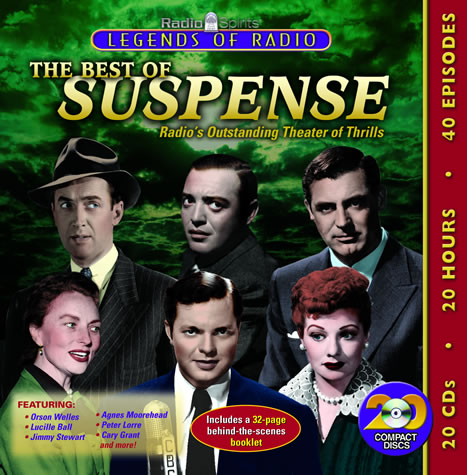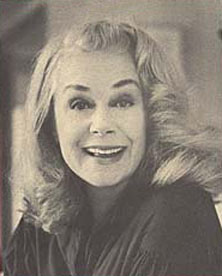"The
Golden Age
of Radio"
(As originally broadcast on WTIC, Hartford, CT)

Click on the link below to hear
Program 8 - November, 1970 - William Spier and June Havoc


CD Cover June Havoc
Program
8 - November, 1970 - William Spier
and June Havoc
Note: This is a large file; it may take a long time to load.
You can save the file to your hard drive by placing your curser over the link,
pressing the right mouse button, and selecting "save target as . . ."
With a T1, cable modem, or DSL this might take 1-3 minutes.
Return to Log of Programs
(As originally broadcast on WTIC, Hartford, CT)

Click on the link below to hear
Program 8 - November, 1970 - William Spier and June Havoc


CD Cover June Havoc
This show's subjects were producer William Spier and his wife, actress June Havoc. William Spier was closely identified with two programs; Sam Spade, and Suspense. One of the premier programs of the Golden Age of Radio, Suspense advertised itself as "radio's outstanding theater of thrills." The sponsor became Roma Wines and then Autolite Spark Plugs; eventually Harlow Wilcox (of Fibber McGee and Molly) became the pitchman. William Spier, William N. Robson, and Anton M. Leder were among the producers and directors. The single most popular episode of Suspense is "Sorry, Wrong Number," written by the premier radio scribe Lucille Fletcher, in which a panicked, bedridden woman (played by veteran radio actor Agnes Moorehead) tries to convince a telephone operator she has overheard a murder plot on a crossed line. First broadcast on May 25, 1943, it was repeated seven times (last on 2/14/60) and spawned the 1948 film with Barbara Stanwyck in the lead role. Another noteworthy episode was Orson Welles' "The Hitchhiker". The program began in 1942 under the supervision of our guest, William Spier, who is the director most associated with "Suspense" in the minds of modern-day enthusiasts. It was Spier who established the basic ground rule for the series; tightly written thriller stories based not on boogeymen but on plausible real-life situations. Spier's "Suspense" tends to revolve around ordinary people caught up in circumstances beyond their control. Spier's casts were usually headed by name stars -- backed by a solid stock company of experienced radio actors. Spier's wife, the sister of the stripper Gypsy Rose Lee, with whom she was driven into performance by an ambitious stage mother, June Havoc began playing bits in silent film shorts at age two, appearing in 24 Hal Roach comedies. She was earning $1500 a week as a vaudeville headliner by the time she was five. At age 13 she married the first of three husbands, and in her late teens, during the Depression and the demise of vaudeville, she modeled and participated in dance marathons (she still holds a record for marathon dancing in 1933), then went on to perform in Catskill Mountain resorts and in stock. In 1936 she made her Broadway debut. Four years later, she scored a big success in the 1940 production of Pal Joey, after which she was invited to Hollywood. She debuted onscreen as an adult in 1941, and over the next decade played leads and second leads in many films. However, Havoc never became a top star and found herself cast in routine films; she rarely appeared onscreen after 1952. Her stage work was more successful, and in 1944 she won a Donaldson Award for Mexican Hayride; she also did much work on TV. She wrote and directed the autobiographical Broadway play Marathon 33 (1963), and authored an autobiography, Early Havoc (1959). She was portrayed as a juvenile stage performer in the Broadway show Gypsy and its screen version. ~ All Movie Guide Note: From Ms. Havoc's personal assistant, Tana Sibilio, 11/5/06: "During one crime melodrama on Sam Spade, perhaps, a sound effect gunshot went off too close to Miss Havoc and actually set her skirt on fire! Trouper that she was, she kept calmly reading her script--of course the show was going out live (although likely being transcribed for later broadcast to the "other" coast) while the control booth went nuts and the props guy threw some water on her. If Bill Spier hadn't been in love with her already, her sang-froid while literally on fire, let alone under it, would have sealed the deal! And Miss Havoc says that's what won her admission in the special cadre of radio actors." Ms. Havoc died on March 28, 2010, at age 97. |
Note: This is a large file; it may take a long time to load.
You can save the file to your hard drive by placing your curser over the link,
pressing the right mouse button, and selecting "save target as . . ."
With a T1, cable modem, or DSL this might take 1-3 minutes.
Return to Log of Programs